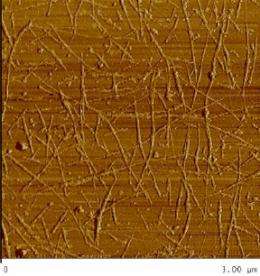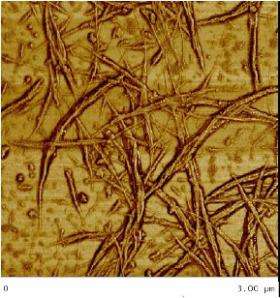Carbon nanotube 'ink' may lead to thinner, lighter transistors and solar cells

(PhysOrg.com) -- Using a simple chemical process, scientists at Cornell and DuPont have invented a method of preparing carbon nanotubes for suspension in a semiconducting "ink," which can then be printed into such thin, flexible electronics as transistors and photovoltaic materials.
The method, which involves treating carbon nanotubes with fluorine-based molecules, is reported in the Jan. 9 issue of the journal Science (Vol. 323 No. 234). The research was jointly led by Graciela B. Blanchet, a research fellow at DuPont, and George Malliaras, Cornell associate professor of materials science and engineering and the Lester B. Knight Director of the Cornell NanoScale Science and Technology Facility. Helen Lu, a research chemist at Dupont, and Mandakini Kanungo, a former Cornell postdoctoral fellow now at Xerox, also worked on the project.
Carbon nanotubes are good candidates for transistors in low-cost, printable electronics, but only after large quantities of them have been converted into semiconductors. When carbon nanotubes are grown in the lab, some are semiconducting but others are metallic, and they are difficult to separate from each other.

This mix is a major drawback in creating transistors from nanotubes, Malliaras said. The Cornell/DuPont team concentrated on a new, inexpensive way to eliminate the metallic tubes, preparing them for such applications as suspension in semiconducting ink for printing.
To do so, the researchers brought fluorine-based molecules into contact with the nanotubes. Through a process called cycloaddition, the fluorine molecules efficiently attacked or converted the metallic nanotubes, leaving the semiconducting tubes alone, and creating a perfect batch of solely semiconducting nanotubes.
"Our work suggests that careful control of the chemical reaction enables the complete conversion of metallic tubes without the degradation of semiconducting tubes," Blanchet said.
The work should lead to exploration of a wide range of devices, such as novel organic photovoltaic structures, Malliaras added.
For the past several years, scientists from Cornell and DuPont have worked together on a variety of projects involving flexible electronics. The research is funded by a grant from the U.S. Air Force for developing transistors from carbon nanotubes.
Provided by Cornell University





















